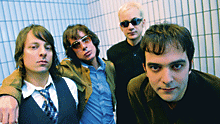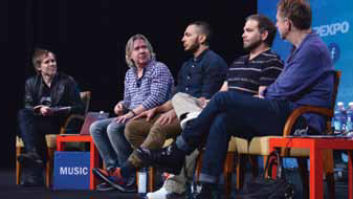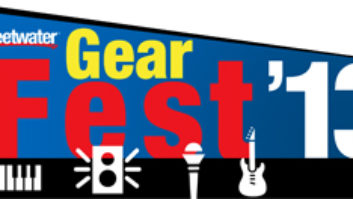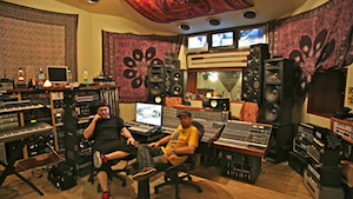

When Fountains of Wayne started making plans to record their new album, Traffic and Weather (out April 3 on Virgin Records), co-founder/bassist Adam Schlesinger thought a change in scenery and work mode would rekindle their creative fire after a four-year break from recording together. Their 2003 release, Welcome Interstate Managers, yielded such cleverly written gems as “Stacy’s Mom,” “Bright Future in Sales” and 14 other exceedingly catchy, hard-to-follow numbers. The album also earned the New York-based band two Grammy nominations, including “Best New Artist” — never mind that the band formed more than a decade ago. After releasing a collection of B-sides, Out-of-State Plates in 2005, the Fountains turned themselves back on.
Fountains of Wayne, from left: Brian Young, Jody Porter, Chris Collingwood and Adam Schlesinger
They booked a week at Bearsville Studio (they were one of the last groups to work in the Turtle Creek Barn before the studio closed) near Woodstock, N.Y., with the intention of writing, arranging and recording as a unit. After a week of noodling, however, they realized that their usual routine worked pretty well after all, and off they went to their usual studio — Stratosphere Sound in New York City’s artsy West Chelsea neighborhood — and their usual process of writing on their own and then bringing those songs to the studio for the band to arrange and record together.
Although it didn’t work for a full album, the band’s week in the country wasn’t a total waste; they emerged with one keeper track (“Strapped for Cash”), a whole hard drive full of songs-in-the-making and a stronger realization that after delivering jubilant, guitar-fueled power pop for more than a decade, each member intuitively knows how and what to contribute. “After playing as a foursome for so long, everybody really has a role to making it sound like it sounds,” says Schlesinger, who produced the album and owns Stratosphere Sound with Smashing Pumpkin James Iha and Andy Chase, Schlesinger’s bandmate in Ivy.
After taking some time out to write, principal songwriters Schlesinger and co-founder/guitarist Chris Collingwood joined lead guitarist Jody Porter and drummer Brian Young to get the songs nailed down and then record basic tracks with Stratosphere’s chief engineer, Geoff Sanoff. Aside from coordinating four hectic schedules, there’s not much pre-planning before they get there; the band works better by simply reacting to the songs as they’re brought to the table. “We’ll bring a song in, then Brian will come up with a feel for it, cut a basic track, then we’ll spend a lot of time with Jody experimenting with different guitar parts,” says Schlesinger. “On this album more than any, you can really hear Jody’s playing and the incredibly wide range that he’s capable of.”
Porter’s versatility came through more abundantly this time due to one slight change in recording technique: trading the Studer 827 2-inch analog machine for the studio’s Pro Tools HD workstation for tracking. The move from tape to disk enabled them to experiment more and ultimately layer guitars, vocals, keyboards and even horns more liberally and efficiently. “We had always at least recorded the basics [to analog] and then dumped it into Pro Tools,” says Schlesinger, “but it’s gotten to the point now where I don’t even know if you’re gaining anything from that.”
Sanoff and band worked in Stratosphere’s Studio A, home to a classic Neve 8068 console with GML Automation, Genelec monitors, a solid inventory of outboard gear and microphones, and a musician’s dream of classic guitar amps, a Baldwin baby grand piano and dozens of vintage keyboards. “In general, our philosophy is to start out with rich, warm sounds, and then you can always dicker ’em up in the computer and play with them later,” says Schlesinger. “But you want the original signal to be as nice-sounding as you can — even if in the end you make it sound like it was run over by a truck.”
Sanoff recorded the drums first, with either Collingwood or Schlesinger (depending on who wrote the song) laying down a scratch vocal and rhythm guitar track at the same time. Aiming to capture a combination of close-miked and room sounds, Sanoff used Coles 4038 ribbon mics on the overheads, Shure SM57s and AKG 441s on the snare, Sennheiser 421s and AKG 414s on the toms, either a Shure Beta 52 or AKG D-112 on the inside of the kick drum, and a Neumann FET 47 on the outside. For room mics, he used Neumann 87s through a Summit Audio DCL-200 compressor; for color, a Beyer M88 through a UREI 1176. “To me, the overhead mics and the room mics are the most important mics on the kit because they allow you to adjust the ambience of the drums from small to big,” says Sanoff. “The song ‘’92 Subaru,’ for example, is sort of Doobie Brothers-esque, so it’s supposed to have that tight, ’70s sound. You get a lot of air with the Coles mics, but if you set them up right, you can still have a reasonably close-sounding drum kit and still get a lot of nice detail.”
Collingwood and Porter had free rein of the studio’s guitar amp collection, deciding on an assortment of Matchless, Vox and Marshall amps. Sanoff usually miked these with Royer 121 and Sennheiser 421s, and then blended them together in various configurations to create a full rhythm guitar sound. Most of the guitar tracks also ran through an Empirical Labs Distressor or a UREI 1176. Porter played through Vox amps for most of his leads, at times choosing one of Iha’s 12-string guitars. “We have a lot of James’ guitars, and he has a lot of beautiful ones,” Sanoff says. “He’s got this awesome old Fender 12-string: As soon as you plug it in, it sounds like The Byrds. It’s just amazing.”
Schlesinger filled out the low end with either a Gibson Thunderbird or Fender Jazz bass paired with an Ampeg B15 bass/guitar amp, which Sanoff miked with a Neumann U47 through a Tube-Tech MP 1A 2-channel mic preamp.
Collingwood and Schlesinger share songwriting credits and vocal duties, although their vocal mic requirements vary. Schlesinger says he’ll sing into whatever’s put in front of him. Collingwood takes a similar laid-back approach, with one caveat: No U47! Apparently, the classic mic sounds great on almost anything — except Collingwood’s vocals. For Traffic and Weather, Sanoff used his own Blue Baby Bottle. “It’s got a bright, brash sound, and for Chris’ vocals, it’s prefect. We used it on pretty much every song.” Meanwhile, Schlesinger sang through either the Baby Bottle, a Neumann U87 or the U47, with either a UREI LA-2A or Distressor powered up for compression.
Between the vintage Neve console, excellent microphones and, most importantly, the musical proficiency of all four bandmembers, Sanoff’s role didn’t entail a lot of tweaking. They used plug-ins only to add in the random odd effect, such as the Line 6 Echo Farm-generated effects on “Strapped for Cash.” They did spend some extra time after tracking the basics to add in horns, keyboards and additional background vocals, which are layered more abundantly than on the Fountains’ previous three studio albums. Schlesinger handled much of the editing, then passed on the tracks to John Holbrook, who mixed 12 of the album’s 14 tracks, and Michael Brauer, who mixed the remaining two.
Holbrook, who has worked on several of Schlesinger’s outside productions (Verve Pipe, David Meade, Ivy), as well as Fountains of Wayne’s Welcome Interstate Managers (which earned them two Grammy nominations in 2004), noted that Schlesinger’s rough mixes already sounded pretty darn good to begin with, some requiring only minimal EQ to bring them to master quality. After splitting out the tracks on Stratosphere Sound’s Neve, Holbrook went to work on creating a mix that would keep the guitars at the forefront without overpowering the band’s pristine vocals and harmonies. He brought back the UREI 1176 and Distressor to polish the guitars and lead vocals, a Universal Audio 175 tube limiter on acoustic guitar, and a Tube-Tech LCA 2B stereo compressor and a pair of dbx 160s on other elements to fine-tune the mix. On the stereo bus, he employed the Smart Research C2 compressor. For the drums, Holbrook broke out his secret weapon: FMR Audio’s Really Nice Compressor. Really. “It’s almost like having a stereo Distressor, but it doesn’t have all the bells and whistles,” he says. “I recommend that everyone should have at least one really nice compressor!”
Brauer, meanwhile, mixed the first two singles, “Someone to Love” and “’92 Subaru,” at his room at Quad Studios in New York on their SSL 9000 J, while his sound towers — four tall racks comprising an exhaustive assortment of limiters, compressors, reverbs and other effects — worked their magic behind him. He agrees with Holbrook that the rough mixes didn’t require much effort. “It’s not often that someone brings in roughs that feel complete,” says Brauer. “If they did, I’d be on the bread line!” Both engineers mixed to half-inch at 30 ips, then printed digitally to Pro Tools.
Loyal Fountains of Wayne fans will be pleased to discover a new cast of oddball characters on this record, such as “Michael and Heather at the Baggage Claim,” “Yolanda Hayes” (their special new friend at the Department of Motor Vehicles) and the hot-and-heavy news team on the title track. Musically, the album jumps with the jangly guitar-pop one would expect from the band, with occasional detours into classic ’70s pop.
“We like really eclectic records. We like records that skip all over the place, and I think our records have gotten progressively more like that,” says Schlesinger. “For us, that’s what keeps it fun, instead of saying, ‘This is going to be an all-loud or all-soft record,’ we just take it song by song. When we mastered our last record, [engineer] George Marino said, ‘Nobody really makes records like this anymore.’ On most of the records he gets, all of the songs kind of sound the same. If you like the single, then you’ll get a bunch of other songs that sound kind of like the single but maybe not as catchy. Our records are just getting more schizophrenic.”

LISTEN: Audio Clip
Strapped For Cash Edit.mp3





